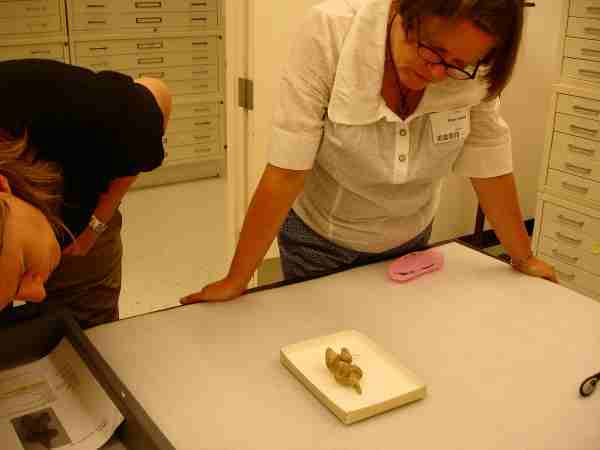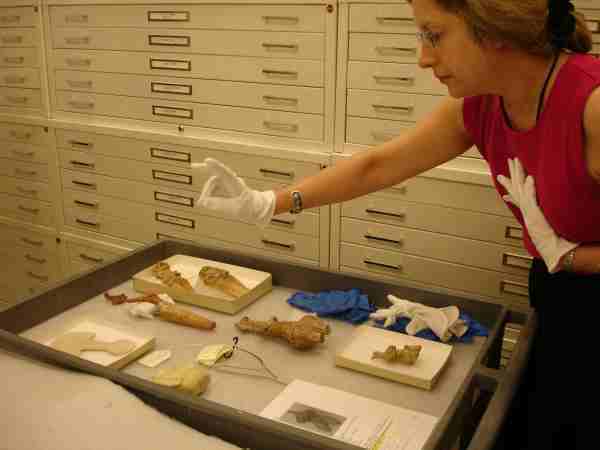The Fertile Goddess: Consultants and Colleagues
Co-curator Maura Reilly, consultant Ellen Belcher, and the Halaf figurine.
During the planning stages of special exhibitions or permanent installations, it is a common practice in museums to involve consultants; scholars with specialized knowledge who assist the curators in researching objects. For The Fertile Goddess, we were very lucky to have Ellen Belcher as a volunteer consultant. Ellen came and spent a glorious and fun early September afternoon in storage with us looking at all the figurines and shared hours of editing with me on the labels and wall texts for the exhibition. She is an Ancient Near Eastern archaeologist and art historian whom I have known for years. We have been in classes and seminars together at the Institute of Fine Arts, New York University and at Columbia University, where she is currently a Doctoral Candidate in Art History and Archaeology – along with working full time as a librarian at John Jay College of Criminal Justice.
Early in 2008, I attended a lecture at Columbia titled, “Embodying the Halaf: Prehistoric figurines from Northern Mesopotamia,” that Ellen gave on her dissertation topic. Co-curator of The Fertile Goddess Maura Reilly and I were already discussing the possibility of focusing on the Fertile Goddess for the next Herstory Gallery exhibition and featuring the Halaf period figurine from our collection. I came away from that lecture – and a subsequent one in May – with a greatly increased understanding of these figurines and other types that existed in Neolithic Mesopotamia. Ellen’s perspective was particularly important because of her work in the field; since 1995, she has excavated in Syria, Jordan and Turkey, where she has been a field supervisor and small finds specialist at the 6th millennium site of Domuztepe for the past decade. Many questions remain about the functions of these figurines in ancient societies and current scholarship has come to consider provenance and archaeological context crucial issues for any understanding of these objects.
Pondering the “Bird Ladies.”
I also was inspired by the work of another colleague (and good friend) in a more indirect way while I was researching our so-called Bird Lady figurines from Predynastic Egypt. Aware that other figurines types existed in Egypt during this period, I was able to see some actual examples In the Predynastic and Early Dynastic Egyptian galleries at the Metropolitan Museum of Art, with extremely informative chat labels written by Diana Craig Patch, an Associate Curator of Egyptian Art there. I felt that Diana, like Ellen, had thoughtfully framed the questions of function and interpretation that still surround these objects. The Predynastic period is one of Diana’s specializations and, having worked extensively in the field in Egypt, she has a strong understanding of archaeological background and issues. I was therefore delighted when both Ellen and Diana agreed to speak at a panel which will take place tomorrow in the Forum. This is a chance for them to show the numerous other types that were contemporary with the two earliest figurines in the exhibition, the Halaf figurine from Mesopotamia and the Bird Ladies from Egypt and to discuss their latest thoughts about the possible functions and interpretations of these objects. Perhaps they will also share their thoughts about being a feminist archaeologist in the 21st century.

Madeleine Cody is a Research Associate for Egyptian, Classical, and Ancient Middle Eastern Art. She has a B.A. in Classical and Near Eastern Archaeology from Bryn Mawr College, an MA in Egyptology from Brown University, and is currently completing her Ph.D. in Egyptian and Ancient Near Eastern Art and Archaeology at the Institute of Fine Arts, New York University. She has worked on excavations in Italy, Yemen and Egypt. Since coming to the Museum in 1997, she has been involved with numerous projects and assisted the late James F. Romano, Project Director, with the second phase of the reinstallation of the Egyptian Galleries, which opened in 2003. With Jim and Richard A. Fazzini, she is a co-author of Art for Eternity: Masterworks from Ancient Egypt (Brooklyn, 1999) and has written about other Egyptian objects from the Museum’s collection. Currently, she is working with the ancient Middle Eastern Art collection, her other area of expertise. She is co-curator of the Herstory Gallery exhibition, The Fertile Goddess, (December 19, 2008 – May 31, 2009).


